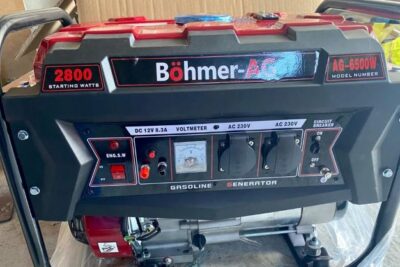This post contains affiliate links.
With the increase in generators for camping, if you do not camp often, you must ensure that you prepare your generator correctly for storage. It is not as simple to place it in the garage and forget about it until the next trip.
What do you need to do to prepare a generator for storage?
Generators should be stored in a dry area, a garage, an outhouse or a shed. Clean and remove any debris, dust and spilt fluids. Check for any damaged wires, hoses or loose bolts. Fuel left inside a generator, add a fuel stabilizer to a topped-off fuel tank. Remove fuel from the carburettor and fuel lines to avoid clogging.
For both short and long-term fuel, a stabilizer must be added. Another option is to drain fuel or run until it runs dry. For long-term storage
How long can I store my generator?
Generators can be stored for a few days to a few years. However, the duration does determine the preparation required.
A generator stored for less than two weeks does not require the same preparation as a generator stored for more extended periods. Fuel will deteriorate after 30 days, so you must add a fuel stabilizer and remove fuel from the carburettor and hose lines to avoid clogging. Please remove the battery and place it on a trickle charge for extended periods to prevent depletion.
Generator storage requirements will differ. Reading the manual before storage is essential. However, if you leave fuel in your generator, don’t leave it half full. Fill the fuel tank to the max and add a fuel stabilizer. If a generator is only partially filled, condensation will build up inside, damaging your fuel and generator.
It is also recommended for more extended storage to run your generator every 3-6 months and replace any used fuel inside.
How to store your generator: Short and long-term
Before storing any generator, it is essential to disconnect any electrical devices and allow the generator to cool down. Complete a safety check. Checking for leaks in hose, decay of hoses and wiring.
Always read the manufactures manual before storage is essential as you do not want to invalidate your warranty.
| Up to 2 weeks | Long-Term Storage |
|---|---|
| Clean and remove any dust or debris | Clean and remove any dust or debris |
| Fuel options | Fuel options |
| 1 – Fill fuel to the max and add fuel stabilizer (Run for 10 minutes to circulate) 2 – Drain fuel via a drainage valve and store it safely. 3 – Run the generator until dry. | 1 – Fill fuel to the max and add fuel stabilizer (Run for 10 minutes to circulate). Run every 2-3 months and replenish with fresh fuel and stabilizer. 2 – Drain fuel via a drainage valve and store it safely. 3 – Run the generator until dry. |
| Remove access fuel from the carburettor and fuel hose by turning off the fuel valve and running the generator until it stops. | Remove access fuel from the carburettor and fuel hose. |
| 1 – Fill fuel to the max and add fuel stabilizer (Run for 10 minutes to circulate). Run every 2-3 months and replenish with fresh fuel and stabilizer. 2 – Drain fuel via a drainage valve and store it safely. 3 – Run the generator until dry. | 1 – Fill fuel to the max and add fuel stabilizer (Run for 10 minutes to circulate). Run every 2-3 months and replenish with fresh fuel and stabilizer. 2 – Drain fuel via a drainage valve and store it safely. 3 – Run the generator until dry. |
| Remove spark plugs and add 2-3 teaspoons of oil to cylinders. Crank the engine to lubricate the cylinders. |
How to store a propane generator?
Propane generators do not need as much preparation as fuel generators because they are clean-burning generators. No residue can clog the carburettor, and you do not need to empty a fuel tank or lines. However, if you have a dual generator, used fuel and propane, you must carry out additional preparation ready for storage.
Once you have disconnected the propane hose from the generator, it is safe to store for a short period without disconnecting the battery. However, it is advisable to clean the outside to remove dust particles.
How do I store a portable solar generator?
Solar generators do not need as much preparation as fuel-run generators for short or long-term storage.
- Disconnect any electrical devices.
- Remove any solar panels that may be connected.
- Fully charge battery
- Clean entirely, removing dust and debris.
- Store in a dry, cool place but not where the temperature will drop below zero.
- Check over a period of time the battery charge. If dropping, recharge to 100%.
Batteries will lose power quickly if stored in a below-freezing or low-temperature environment. I keep my Jackery inside my house, away from where it can be damaged.
Can I store a portable generator outside?
Generators should not be stored outside. Storing a generator outside in the rain or cooler weather can cause damage. Even underneath a shelter, such as a tarp, will not stop the generator’s body from becoming wet. Wires, tubing, and internal components will be affected by weather conditions and can corrode.
A generator should always be stored in a dry area, not where weather conditions can harm it.
Related questions
Why do I need to add a fuel stabilizer to my generator?
A fuel stabilizer is required to prolong the life of diesel and petrol (gasoline) as it breaks down and causes problems with your generator over time. It is essential to consider other factors that may affect fuel.
- Is the fuel in a sealed container?
- Outside temperatures. (sun, heat, moisture)
- It needs to be stored in a cool, dry area.
You can leave fuel in the tank if you store a portable generator for less than two weeks. However, adding a fuel stabilizer on average of 30ml per 9.5 Ltrs of fuel is advisable. The easiest way to add a stabilizer is to fill your tank and measure accordingly. Don’t try to guess how much fuel you have in the tank.
I always add a fuel stabilizer. I was recommended STA-BIL from Amazon a couple of years ago, and it worked perfectly. You can buy from local car part retailers, but I found Amazon cheaper. It has prevented the fuel from breaking down inside my generator, which can cause issues with starting up by clogging lines and carburettors.
Should I keep my generator’s battery charged during non-usage?
If you are storing your generator for long periods, you must remove the battery to avoid depleting entirely. The battery should be disconnected from your generator and stored in a cool, dry place. A trickle charge will only charge your battery if it senses the battery power dropping. It does not continuously charge.
To avoid complete power loss from the battery, you can keep it charged with an automatic trickle charger and battery maintainer. A trickle charger will keep your battery charged over more extended periods.
Some trickle charges can jump-start your battery and be used on vehicles; however, these are more expensive. I use the Noco GENIUS5UK from Amazon, suitable for motor vehicles and generator battery monitoring. It is one of the more expensive trickle chargers., However, it is compact and can be tucked away. I keep it in the spare tyre well of my care alongside the first aid kit. That way, I have it ready for emergencies when car camping. It gives me a piece of mine when I am exploring with my son.
Keeping a trickle charge on hand is an excellent solution to keeping your generator battery charged. It is worth investing in for other emergencies, especially on cold mornings when you have a flat car battery.


